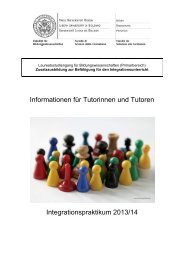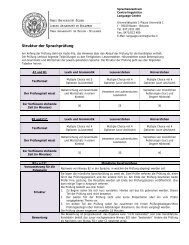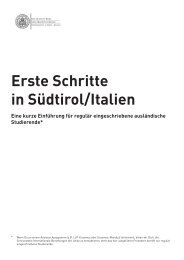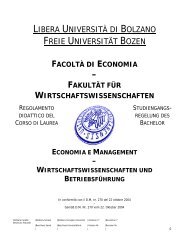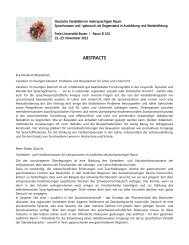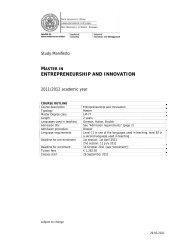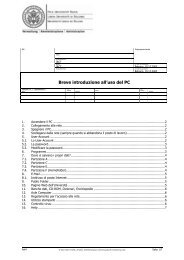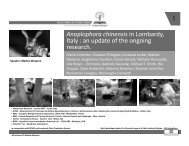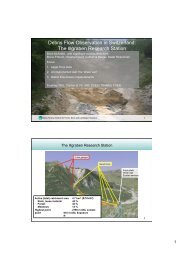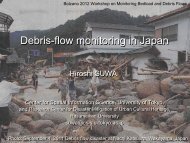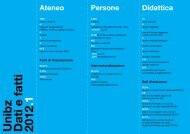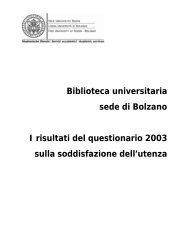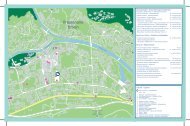Create successful ePaper yourself
Turn your PDF publications into a flip-book with our unique Google optimized e-Paper software.
8<br />
<strong>di</strong>spoRRe spazi<br />
che geneRano<br />
senso<br />
Paolo volonté<br />
La vita si <strong>di</strong>pana in un mondo fisico che pone dei vincoli e<br />
offre possibilità. Non possiamo passare attraverso i muri,<br />
ma troviamo da bere e <strong>di</strong> che ripararci. Il mondo fisico che ci<br />
circonda non è, però, neutrale per noi, come potrebbe esserlo<br />
per la pietra trascinata a valle dal torrente. È invece un mondo<br />
denso <strong>di</strong> senso. E non da ora. Ben prima dello sviluppo<br />
della civiltà le cose non erano già più, per l’essere umano,<br />
mere “cose”, ma potevano acquisire lo status <strong>di</strong> segni, in<strong>di</strong>catori<br />
<strong>di</strong> qualcosa d’altro, portatori <strong>di</strong> un significato. La capacità<br />
umana della significazione trasforma il mondo delle cose in<br />
un mondo <strong>di</strong> segni, e quin<strong>di</strong> in un mondo <strong>di</strong> cultura: cultura<br />
in<strong>di</strong>viduale e cultura sociale. Lo spazio circostante non è più<br />
solo paesaggio naturale. È paesaggio popolato d’impronte e<br />
segni d’animali che l’essere umano <strong>di</strong>stingue, riconosce, segue<br />
o sfugge a seconda dei propri bisogni, e arricchito anche<br />
dai segni appositamente <strong>di</strong>sposti da altri esseri umani per<br />
comunicare la <strong>di</strong>rezione, il luogo, la pre<strong>di</strong>sposizione amichevole<br />
o bellicosa. Quando, dunque, la natura viene espulsa dal<br />
nostro orizzonte esperienziale, o relegata in fazzoletti <strong>di</strong> terra,<br />
e sostituita da muri, colori, immagini, luci, la trasformazione<br />
cui assistiamo non è nulla d’essenziale, <strong>di</strong> qualitativo. È, se si<br />
vuole, il preve<strong>di</strong>bile destino dell’ambiente <strong>di</strong> un essere dotato<br />
<strong>di</strong> capacità <strong>di</strong> significazione, un destino già inscritto nello<br />
sguardo del primitivo che riconosce l’impronta dell’orso. La<br />
cultura non è nelle cose, ma nello sguardo che osserva le cose.<br />
Lo spazio circostante <strong>di</strong> ciascun essere umano è, potenzial-<br />
mente, uno spazio <strong>di</strong> senso. Lo spazio comune uno spazio <strong>di</strong><br />
senso comune. È nello spazio comune che nasce, infatti, la<br />
possibilità per molti in<strong>di</strong>vidui <strong>di</strong> con<strong>di</strong>videre una medesima<br />
costellazione <strong>di</strong> senso, medesime credenze, medesimi racconti,<br />
lo stesso sentimento <strong>di</strong> appartenere a una collettività. Ciò che<br />
chiamiamo la sfera pubblica. Oggi la sfera pubblica sembra<br />
essere definitivamente sganciata dalla <strong>di</strong>mensione dello spazio.<br />
Oggi siamo abituati a pensare che il senso comune <strong>di</strong> una<br />
collettività maturi attraverso la comunicazione me<strong>di</strong>ata. Sono<br />
i giornali, la televisione, la rete a costruire la sfera pubblica.<br />
Ma questa sfera pubblica è in realtà figlia ed evoluzione dello<br />
spazio pubblico che si apriva al centro dell’intrico <strong>di</strong> strade<br />
delle città premoderne: il mercato, il foro e, alle origini, l’agorà.<br />
Dimenticare queste origini significherebbe perdere <strong>di</strong> vista<br />
che anche oggi, nella società delle “seconde vite” che aspira a<br />
farsi totalmente virtuale, lo spazio fisico, lo spazio pubblico<br />
costituisce uno dei principali orizzonti <strong>di</strong> senso dell’attore<br />
sociale.<br />
Non penso soltanto alle manifestazioni <strong>di</strong> piazza, alle manifestazioni<br />
sportive o alla pratica dello shopping, ma anche e<br />
soprattutto alla vita <strong>di</strong> tutti i giorni: alla strada da percorrere<br />
per andare al lavoro, ai giar<strong>di</strong>ni dove portare il bimbo o il<br />
cane, allo spiazzo dove fermarsi a mangiare il gelato. La vita<br />
quoti<strong>di</strong>ana si <strong>di</strong>pana dentro a spazi pubblici, l’attore sociale<br />
li visita, li abita, li utilizza, e così facendo li legge e interpreta,<br />
conferisce loro un senso. O per meglio <strong>di</strong>re: produce un<br />
senso a partire da colori, oggetti, persone, usi che le persone<br />
fanno dello spazio, immagini, cartelloni pubblicitari, “arredo<br />
urbano” e arredo spontaneo che lo decorano. Perciò ogni<br />
formazione, trasformazione o deformazione <strong>di</strong> spazi pubblici<br />
è in se stessa una trasformazione del senso comune, della<br />
sfera pubblica. E lo è ben oltre le intenzioni <strong>di</strong> chi la produce.<br />
Come la pensilina dell’autobus bruciata produce significati<br />
che il teppista nemmeno immagina, così la nuova pensilina<br />
produce significati che l’architetto o il designer non hanno<br />
immaginato. I paracarri <strong>di</strong>vengono panchine, le panchine<br />
paracarri. Al progettista probabilmente non resta che <strong>di</strong>sporre<br />
forme, oggetti, colori e immagini nello spazio sapendo che<br />
esso è ambiente <strong>di</strong> esseri capaci <strong>di</strong> significazione. Sapendo<br />
che ogni intervento sarà motivo <strong>di</strong> una nuova generazione <strong>di</strong><br />
senso.<br />
oRganising space that engendeRs<br />
meaning — Life unwinds in a physical world that sets<br />
constraints and offers opportunities. We cannot get past the<br />
walls, but we can find something to drink and somewhere<br />
to shelter. But the physical world that surrounds us is not<br />
neutral for us as it could be for a stone carried down into<br />
a valley by a torrent of water. Instead, it is a world full of<br />
meaning and not just as of now. Long before the development<br />
of civilisation, things were already no longer just things for<br />
human beings, but had acquired the status of signs, in<strong>di</strong>cators<br />
of something else, and harbingers of meaning. The human<br />
capacity for meaning is transforming the world of things<br />
into a world of signs and therefore into a world of culture;<br />
in<strong>di</strong>vidual and social culture. The surroun<strong>di</strong>ng space is<br />
no longer only natural landscape. It is a landscape full of<br />
footprints and signs of animals that humans <strong>di</strong>stinguish,<br />
recognise, follow or escape from, accor<strong>di</strong>ng to their needs,<br />
and enriched also with signs appropriately arranged by<br />
other humans to show the way, the place or their friendly<br />
or bellicose <strong>di</strong>sposition. When therefore nature is expelled<br />
from our experiential horizon or relegated into parcels of<br />
land and replaced by walls, colours, images and lights, the<br />
transformation we witness is nothing essential or qualitative.<br />
If we want, it is the pre<strong>di</strong>ctable destiny of the environment of<br />
a being equipped with ability and meaning, a destiny already<br />
written on the face of a prehistoric man who recognises the<br />
footprint of a bear. Culture is not in things but on the face of<br />
who is observing these things.<br />
The space surroun<strong>di</strong>ng each human being is potentially<br />
a space of meaning. The common space is a space of<br />
common meaning. In fact, it is in the common space that<br />
the opportunity emerges for many in<strong>di</strong>viduals to share the<br />
same constellation of meaning, the same beliefs, the same<br />
stories and the same feeling of belonging to a community.<br />
That is what we call public sphere. Today, it appears to be<br />
permanently unhooked from the <strong>di</strong>mension of space. Today,<br />
we have become used to think that the common meaning of a<br />
community ripens via the me<strong>di</strong>a. Newspapers, the television<br />
and the net create this public sphere. However these public<br />
sphere is really the offspring and evolution of the public space<br />
that opened up at the centre of the network of streets of the<br />
pre-modern city; its market, the forum and originally the<br />
agora. To forget these origins would mean to lose sight of the<br />
fact that even today, in a society of ‘second lives’ that aspire<br />
to become totally virtual, the physical space, the public space<br />
constitutes one of the principal horizons of meaning of the<br />
social actor.<br />
I am not thinking only of demonstrations in the town<br />
square, of sporting events or shopping, but also and above<br />
all of everyday life; for example the journey to work, the<br />
municipal gardens where we go with our children or dogs<br />
and where we stop off to have an ice cream. Everyday life<br />
unfolds inside public spaces, the social player visits them,<br />
inhabits them, uses them and in doing so reads and interprets<br />
them and confers a meaning on them. Or put better, he<br />
produces a meaning beginning with colours, objects, people,<br />
uses that people make of the space, images, publicity<br />
boards, ‘street furniture’ and the unsolicited furniture that<br />
decorate it. Consequently every formation, transformation or<br />
deformation of public spaces is in itself a transformation of<br />
the common meaning of public circles. This is over and above<br />
the intentions of the person producing it. In the same way<br />
that the burnt down bus shelter produces meanings that the<br />
hooligan does not even foresee, the new bus shelter produces<br />
meanings that the architect or designer <strong>di</strong>d not imagine. The<br />
stone posts become benches and the benches stone posts.<br />
Probably the designer can only arrange forms, objects, colours<br />
and images in the space knowing that it is an environment of<br />
beings capable of sense; knowing that every intervention will<br />
be the reason for a new generation of meaning.<br />
sinn schaffen duRch Räume — Die physische<br />
Welt, in der sich unser Leben abspielt, gibt uns gleichermaßen<br />
Grenzen und Möglichkeiten. Wir können nicht durch<br />
Wände gehen, dafür haben wir zu Trinken und ein Dach über<br />
dem Kopf. Aller<strong>di</strong>ngs ist <strong>di</strong>e physische Welt für uns nicht so<br />
neutral, wie sie es einem beliebigen Gegenstand gegenüber<br />
ist. Sie beinhaltet einen tieferen Sinn – und das nicht erst seit<br />
Kurzem: Noch vor der Entstehung der großen Kulturen waren<br />
Gegenstände für den Menschen nicht mehr reine „Dinge“,<br />
sondern konnten Zeichen, Symbole und In<strong>di</strong>katoren sein.<br />
Die menschliche Fähigkeit, Bedeutung beizumessen, macht<br />
aus der Welt der Gegenstände eine Welt der Zeichen, und<br />
damit eine Welt der in<strong>di</strong>viduellen und sozialen Kultur. Unsere<br />
Umgebung ist nicht mehr nur Naturlandschaft. Hier finden<br />
sich Tierspuren, <strong>di</strong>e der Mensch erkennen und zuweisen kann,<br />
<strong>di</strong>e er je nach seinen Bedürfnissen verfolgt oder vermeidet;<br />
hier finden sich vom Menschen hinterlassene Zeichen,<br />
<strong>di</strong>e Richtung, Ort, Gastfreundlichkeit oder Feindseligkeit<br />
kommunizieren. Wann immer also <strong>di</strong>e Natur aus unserem<br />
Erfahrungshorizont verdrängt wird, auf kleine Flecken Erde<br />
verbannt und durch Mauern, Farben, Bilder, Lichter ersetzt<br />
wird, ist das, was vor unseren Augen geschieht, keine wesentliche<br />
oder qualitative Verwandlung. Es ist, wenn man so will,<br />
das vorhersehbare Schicksal der Umgebung eines Wesens, das<br />
Bedeutung zumisst – ein Schicksal, das bereits geschrieben<br />
war, als der Urmensch den Spuren seiner Beute folgte. Kultur<br />
liegt nicht in den Dingen, sondern in der Beobachtung der<br />
Dinge.<br />
Die Umgebung eines jeden Menschen ist potentieller<br />
Raum für Sinn. Öffentlicher Raum ist Raum für Gemeinschaftssinn.<br />
Im öffentlichen Raum können Ansammlungen<br />
von In<strong>di</strong>viduen lernen, eine bestimmte Konstellation des<br />
Sinns, dasselbe Gedankengut, <strong>di</strong>eselben Geschichten und ein<br />
Gefühl der Zugehörigkeit zu teilen – gemeinhin nennen wir<br />
<strong>di</strong>eses Phänomen <strong>di</strong>e öffentliche Sphäre. Heute scheint es, als<br />
bestehe definitiv kein Zusammenhang zwischen ihr und der<br />
räumlichen Dimension; wir denken vielmehr, der Gemeinschaftssinn<br />
entstamme der Kommunikation durch Zeitung,<br />
Fernsehen und Internet. Aber <strong>di</strong>e öffentliche Sphäre geht<br />
viel weiter zurück; sie entwickelte sich mit dem öffentlichen<br />
9



